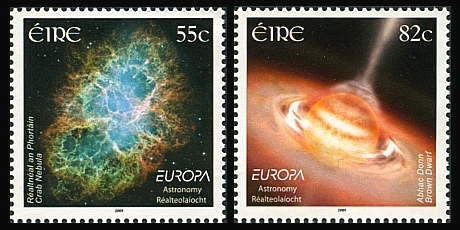2009 International Year of Astronomy
The International Year of Astronomy in 2009 commemorated the 400th anniversary of the first use of an astronomical telescope by the Italian scientist Galileo Galilei, who saw among other wonders the craters of the Moon, the satellites of Jupiter, and sunspots. England celebrated the achievements of Thomas Harriot, an Englishman who beat Galileo by several months but remains much less well known.
In recognition of the IYA, Astronomy was the theme of the 2009 Europa stamps issued by the members of PostEurop, the trade association of European public postal operators which succeeded the European Conference of Postal and Telecommunications Administrations (CEPT) in 1993.
Europa Astronomy (Éire)
Ireland produced two strong designs by Richard Chaney as its contribution to the Europa Astronomy theme, issued on 2009 May 15. AnPost, the Irish postal authority, described them as follows:
‘The 55c stamp bears a picture of the Crab Nebula. First observed by the English astronomer John Bevis in 1731, this nebula was named by William Parsons, the Third Earl of Rosse, based on observations made from Birr Castle, Co Offaly. The brightest and most recent supernova close to the Earth, this may very well be the most-studied object in the sky. It is associated with a number of important scientific discoveries in Ireland.’ [The source of the Crab Nebula photograph was not stated, but it was taken by the Hubble Space Telescope.]
‘The 82c stamp shows an artist’s impression of jets from a brown dwarf. These are astronomical objects whose mass is smaller than that of a star but larger than that of the largest planets. There is a great deal of research being carried out on brown dwarfs at the moment, with Irish astronomers very much at the forefront.’
The stamps were also issued in sheets of ten, with an illustrated background (see here).
Stanley Gibbons nos. 1964, 1965
